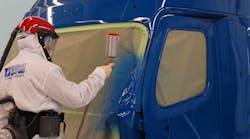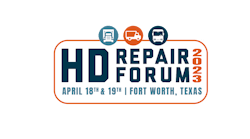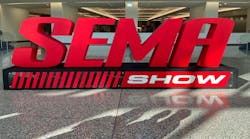Before any paint is applied to a vehicle surface, it is paramount the surface be correctly prepared. Otherwise, improperly prepared surfaces will affect the adhesion of the coating and can reduce the life span of the coating.
Devoting the time and effort to appropriately readying vehicles for painting can help ensure a long lasting gloss and shine.
Toward this end, the Technology & Maintenance Council (TMC) has developed its Recommended Practice (RP) 411A, Vehicle Surface Preparation for Painting. TMC (www.trucking.org/Technology_Council.aspx) is North America’s premier technical society for truck equipment technology and maintenance professionals.
RP 411A states that “vehicle surface preparation prior to painting involves two basic steps. One, the removal of any surface contaminants which may interfere with proper paint adhesion. Second, the use of either a mechanical or chemical system to bond the paint coatings to the surface being painted.”
The RP includes these general surface preparation guidelines:
1. The vehicle should be washed with mild soap and water to remove dirt. It should then be rinsed well with clean water and blown dry or wiped dry with lint free rags.
2. Prior to sanding, the surface should be washed with a good grade of solvent that is designed to remove grease, wax, tar, road grime and other surface contaminants. A clean towel or rag should be saturated with the solvent and applied to a area.
While the solvent is still wet, the area should be wiped with a clean towel to lift and remove contaminants.
TMC advises that shop rags should not be used for these tasks as these may contain contaminants.
3. All paint and rust in the affected area needs to be removed using a grinding disc. Then, apply and finish the body filler per the manufacturer’s recommendations.
After initial leveling and smoothing of the body filler, that area should be sanded with 180 to 220 grit sandpaper, with a final sanding done using an orbital sander. Then, clean that area with a solvent and wipe dry.
4. Apply two to three coats of two-component primer – per the manufacturer’s recommendations – to the surface to cover the body filler. Block sand as needed using 180 to 220 grit sand paper to ensure a smooth profile.
5. The area then should be cleaned with a solvent and spot primed as necessary. Do a final sanding with 220 grit or finer sandpaper.
6. After the sanding operation is complete, blow off all dust, then clean with a solvent.
Once these steps are complete, TMC RP 411A says the vehicle now is ready for application of the appropriate top coat, which needs to be selected to meet the operating needs of the vehicle.
MATERIAL DIFFERENCES
The RP points out that “different substrates require different preparation procedures due to differences in material composition, hardness and the ability to withstand various corrosive substances.”
It offers detailed surface preparation procedures for commonly used materials, including media blasting, steel, aluminum and galvanized metals, fiberglass and composite materials, flexible substrates and painted surfaces.
RP 411A, Vehicle Surface Preparation for Painting is but one of more than 400 RPs contained in TMC’s Recommended Practices Manual. It has been widely recognized as one of the leading equipment maintenance and maintenance shop management information guides available for commercial vehicles.
This manual is available from TMC in both book and CD format. For details, contact TMC by phone at 703838-1763 or email [email protected].
David A. Kolman is editor of Fleet Maintenance, the only publication that provides a wide-ranging curriculum and best practices to enable readers to keep vehicles operating with greatest efficiency and minimal downtime, and improve their personal performance. An award-winning journalist, he has been actively involved in the North American transportation industry for more than 30 years.




